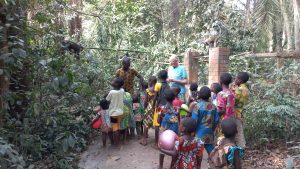In Benin, in the savannah of the Dahomey Gap, sacred forests of <0.5 ha preserve the rainforest flora characteristic of the adjacent forest blocks ‘Upper Guinea’ and ‘Congo Basin’. To protect these threatened plants, we reconstituted a rainforest patch of 14 ha, the ‘Sanctuaire des Singes’, out of fallow land and followed its regeneration since 1995 under threatening urbanization and climate change. The sanctuary also incorporates two remnant sacred forests. The growth of saplings of common trees and the changes in the composition of the flora developing from seeds and roots were analyzed. In collaboration with professors of the University of Abomey-Calavi (UAC), a total of 257 indigenous plant species were sourced from neighboring rainforest patches and introduced into the sanctuary, bringing the total of plant species to 590, making the sanctuary one of the region’s richest rehabilitated rainforests. Management consisted in hand irrigation and mulching of young plants during dry periods and the removal of strangling climbers. Peter Neuenschwander’s residency in the sanctuary and support to the local population with its vodun culture set the stage for his initiation into these cults and for a contentious, but eventually fruitful tolerance and understanding between the IITA scientist and his neighbors.
In a celebration, the title deeds for the forest were handed over to IITA. To help the communities living along the forest margins, sanitary facilities were installed, and a multi-purpose youth center was built. The center now hosts community celebrations, extra tuition for children, women’s clubs, and even serves as a voting site during elections.
With his colleagues of UAC, he and Georg Goergen edited and cowrote the Red List of Benin. Out of the over 100 species of plants listed as threatened, 58 can now be found in the sanctuary, including 12 of them critically endangered according to IUCN criteria. The forest is continuously monitored and changing in its composition, particularly since last year when new waves of storms, engendered by global warming, hit the forest, felled early succession trees, and asked for replanting. On top of this, common herbs and woody plants of pan-African or pantropical origin, some of them invasive species that thrive in the vicinity of the forest, and – to a lesser extent – plants from the Sudan savannah are disappearing from the closed forest, being replaced by rainforest species of Congolian and Upper Guinean origin. In conclusion, as Benin’s first reconstituted ‘reference forest’, the sanctuary possesses important conservation, educational, and scientific value.
The sanctuary is also well known because of its two troupes of about 25 red-bellied monkeys each. These go back to 14 monkeys, which were caught in the Ouémé Valley since 1995, reproduced first in cages and were later freed in the forest. The species is endemic to southern Benin, critically endangered and has been studied in some detail in the sanctuary.
Because of its easy access and despite increasing urbanization, the sanctuary receives numerous visitors, which are mostly attracted by the rather tame red-bellied monkeys – a timid start for ecotourism. The forest serves as an example for better managing sacred forests in the nearby Ouémé floodplain, a UNESCO World Heritage site and is a potential candidate for formal protected-area recognition.



